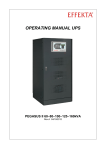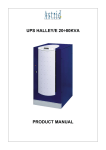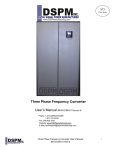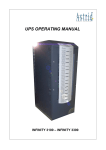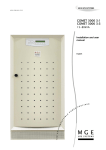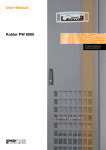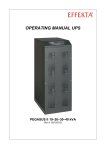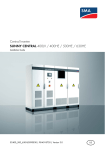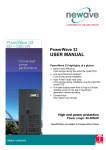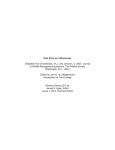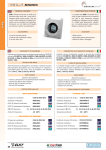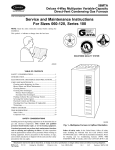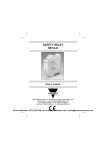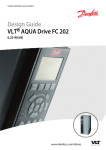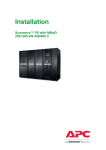Download OMD10010 - Thetys EVO operating manual
Transcript
OPERATING MANUAL UPS MANUALE OPERATIVO UPS THETYS EVO 60–80–100–125–160kVA OPERATING MANUAL UPS MANUALE OPERATIVO UPS Index of sections/Indice delle sezioni Code/Codice 1 – WARNINGS AND GENERAL INFORMATION AVVERTENZE E INFORMAZIONI GENERALI 2 – INSTALLATION AND START-UP OF UPS THETYS EVO INSTALLAZIONE ED AVVIAMENTO 3 – UPS USER MANUAL UTILIZZO DELL’UPS Rev. A B Descrizione Description Emissione Added English language/Aggiunta lingua inglese OMD10011 OMD10013 OMD10012 Data Date Emesso Issued Controllato Checked Approvato Approved Lingua Language Pagina Page 18.11.10 21.12.10 G. Senesi F. Berti V. Gremoli M. Mancini V. Gremoli V. Gremoli E/I 1 di Pag. of Pag. 1 Codice / Code OMD10010 Warnings and general information Avvertenze e informazioni generali WARNINGS AND GENERAL INFORMATION AVVERTENZE E INFORMAZIONI GENERALI Index / Indice ENGLISH LANGUAGE ............................................................................... 3 1 CONVENTIONS USED ........................................................................ 4 2 DOCUMENTATION NOTES ................................................................ 5 3 CONTACTS ......................................................................................... 5 4 FACTORY WARRANTY ...................................................................... 6 5 LIMITATION OF LIABILITY ................................................................ 8 LINGUA ITALIANA ..................................................................................... 9 1 CONVENZIONI UTILIZZATE............................................................. 10 2 NOTE SULLA DOCUMENTAZIONE ................................................. 11 3 CONTATTI ......................................................................................... 11 4 GARANZIA DI FABBRICA ................................................................ 12 5 LIMITAZIONE DI RESPONSABILITA’ .............................................. 14 Rev. A B Descrizione Description Emissione Added English language/Aggiunta lingua inglese Data Date Emesso Issued Controllato Checked Approvato Approved Lingua Language Pagina Page 18.11.10 21.12.10 G. Senesi F. Berti M. Mancini M. Mancini V. Gremoli V. Gremoli E/I 1 di Pag. of Pag. 14 Codice / Code OMD10011 Warnings and general information Avvertenze e informazioni generali 2 OMD10011 REV. B Warnings and general information Avvertenze e informazioni generali ENGLISH LANGUAGE OMD10011 REV. B 3 Warnings and general information Avvertenze e informazioni generali Thank you for choosing an Astrid Energy Enterprises product. This section of the manual contains indications regarding the symbols used in the UPS documentation as well as basic information about the product, including the factory warranty terms. 1 CONVENTIONS USED The following symbols have been used to indicate potential dangers and to highlight useful information, so as to minimize the risks to persons and property. HAZARD “HAZARD” statements contain characteristics and basic instructions for the safety of persons. Non-compliance with such indications may cause serious injury or death. WARNING “WARNING” statements contain characteristics and basic instructions for the safety of persons. Non-compliance with such indications may cause injury. CAUTION “CAUTION” statements contain characteristics and important instructions for the safety of things. Non-compliance with such indications may cause damage to materials. NOTE “NOTE” statements contain characteristics and important instructions for the use of the device and for its optimal operation. 4 OMD10011 REV. B Warnings and general information Avvertenze e informazioni generali 2 DOCUMENTATION NOTES Storing documentation This manual and any other supporting technical documentation relating to the product must be stored and made accessible to personnel in the immediate vicinity of the UPS. Further information In the event that the information provided in this manual is not sufficiently exhaustive, please contact the manufacturer of the device, whose details are available in the “Contacts” section. 3 CONTACTS For any information about the UPS systems manufactured by ASTRID, please contact: Astrid Energy Enterprises S.p.A. Viale Europa, 22 52018 Castel San Niccolò AREZZO Tel. 0575 509701 Fax 0575 500032 [email protected] www.astridups.it For help with technical problems or for information concerning device use and maintenance, please contact the technical help service by phoning the above-indicated telephone number, specifying the following data: Type of device and its nominal power Serial number Error code, if applicable. OMD10011 REV. B 5 Warnings and general information Avvertenze e informazioni generali 4 FACTORY WARRANTY The factory warranty provided by Astrid Energy Enterprises S.p.A. is called “Green Base Warranty” and is subject to the terms indicated below. Validity a) The present warranty terms only apply to the UPS systems manufactured by Astrid Energy Enterprises and to their storage batteries, when supplied by Astrid. Duration a) The factory warranty provided by Astrid Energy Enterprises S.p.A. has a validity of 12 (twelve) months from the startup date of the UPS. The warranty expires at the latest 18 (eighteen) months from the purchasing date (invoicing). General conditions b) The execution of one or more repairs within the warranty time will not alter the original expiry of the warranty. c) If a unit is faulty and/or damaged within the time frame covered by the warranty, it will be repaired or replaced with an equivalent or similar product. Costs a) The warranty covers all the costs resulting from repairs and/or spares to restore the correct operation of the product covered by our factory warranty. b) All other costs, particularly shipping costs, travel and accommodation costs for the service personnel of Astrid Energy Enterprises S.p.A. for on-site repairs, as well as costs for the customer’s own employees, will not be covered by the factory warranty and will be charged to the end customer. c) In case of service performed following a call made by mistake, or in case our technicians incur extra time and/or costs due to the site inaccessibility or due to work interruptions required by the customer, such costs will be invoiced in accordance with ANIE rates CLASS III COLUMN B. Modes required a) In the event of a fault covered by the warranty, the customer shall notify Astrid Energy Enterprises S.p.A. in writing of the occurred fault, providing a short description of the fault. b) The customer shall also provide documents showing the validity of the warranty (receipt/purchasing invoice with serial number of the product – report indicating the startup date). Service at the installation site a) During preventive maintenance visits or emergency service, access shall be ensured to the installation site, and the device shall be made available in order to ensure maintenance or repair with no waiting time. b) During the intervention, the customer’s representative must attend service operations at the installation site, so that he/she may operate the control devices outside the equipment. c) In case entry permits are necessary in order to enter the installation site, Astrid Energy Enterprises S.p.A. must be notified of the time necessary to obtain the documentation required, if any. d) In case of customer’s non-compliance, Astrid Energy Enterprises S.p.A. reserves the right to refuse warranty service. Astrid Energy Enterprises S.p.A. will not accept any product returned for repair or replacement without prior agreement. 6 OMD10011 REV. B Warnings and general information Avvertenze e informazioni generali Exclusions a) Our warranty does not cover the products which are faulty or damaged due to: Transport, Installation or start-up defects caused by the customer’s non-compliance with the installation and use instructions provided by Astrid Energy Enterprises S.p.A. Tampering, alterations or repair attempts made without the specific written approval by Astrid Energy Enterprises S.p.A. Damage caused by work done by personnel not authorized by Astrid Energy Enterprises S.p.A. Damage to the device caused by improper use, negligence, voluntary damage or use of the device beyond the allowed limits; Damage caused by external factors such as dirt, fire, flooding, failed operation of the air conditioning system, etc.; Non-compliance with applicable safety standards; Force majeure (e.g. lightning, surges, natural disasters, fire, acts of war, riots, etc.); Fall or displacement due to incorrect installation; Ordinary wear caused by proper and continuous use of the device. b) Protective devices inside the units (fuses and dischargers) are also excluded from the warranty, unless the failure is due to component faults. Responsibility a) In no event shall Astrid Energy Enterprises S.p.A. be liable for direct or indirect damage, or any damage whatsoever connected with the execution of warranty services (e.g. possible voltage interruptions during the repair period or assembly and dismantling costs), except for the cases provided for by mandatory laws. b) The present warranty terms do not affect the purchaser’s mandatory rights as by law. OMD10011 REV. B 7 Warnings and general information Avvertenze e informazioni generali 5 LIMITATION OF LIABILITY All the information contained in the present documentation is the exclusive property of Astrid Energy Enterprises S.p.A. Written consent by Astrid Energy Enterprises S.p.A. is required in order to wholly or partially publish or disclose this information. The present manual constitutes an integral part of the product technical support documentation. Read the warnings with attention, as they give important instructions concerning safe usage. The equipment must be destined exclusively for the use for which it was expressly designed. Any other use is considered improper and therefore hazardous. The manufacturer cannot be held responsible for possible damage arising from improper, erroneous or unreasonable usage. Astrid Energy Enterprises assumes responsibility for the equipment in its original configuration. Any intervention that alters the structure or the operating cycle of the equipment must be carried out and authorized directly by Astrid Energy Enterprises. Astrid Energy Enterprises will not be held responsible for the consequences arising from the use of non-original spare parts. Astrid Energy Enterprises reserves the right to make technical modifications to the present manual and to the equipment without prior warning. Whenever typographical or other errors are found, the corrections will be included in new versions of the manual. Astrid Energy Enterprises assumes responsibility for the information given in the original version of the manual in Italian language. 8 OMD10011 REV. B Installation and start-up of UPS Thetys EVO Installazione e avviamento Thetys EVO INSTALLATION AND START-UP OF UPS THETYS EVO INSTALLAZIONE E AVVIAMENTO UPS THETYS EVO Index / Indice ENGLISH LANGUAGE ............................................................................... 5 1 SCOPE ................................................................................................ 6 2 SAFETY RULES AND WARNINGS .................................................... 7 2.1 UPS USE ...................................................................................................................... 7 2.2 THETYS EVO RATING ................................................................................................ 8 2.3 SPECIAL SAFETY WARNINGS .................................................................................. 9 2.3.1 General warnings ................................................................................................ 9 2.3.2 Personnel ............................................................................................................ 9 2.3.3 Transport and handling ...................................................................................... 9 2.3.4 Installation ......................................................................................................... 10 2.3.5 Electrical connection ........................................................................................ 11 2.3.6 Operation ........................................................................................................... 12 2.3.7 Maintenance ...................................................................................................... 13 2.3.8 Storage .............................................................................................................. 14 2.4 3 ENVIRONMENTAL PROTECTION ............................................................................ 14 2.4.1 ISO 14001 certification ..................................................................................... 14 2.4.2 Recycling of packing materials ....................................................................... 14 2.4.3 Device disposal ................................................................................................. 14 INSTALLATION ................................................................................. 15 3.1 RECEIPT OF THE UPS.............................................................................................. 15 3.1.1 3.2 Rev. A B C D Storage .............................................................................................................. 15 HANDLING OF THE UPS .......................................................................................... 16 Descrizione Description Emissione Added English language/Aggiunta lingua inglese Correzione/Revision General revision/Aggiornamento generale Data Date Emesso Issued Controllato Checked Approvato Approved 18.11.10 21.12.10 19.01.11 08.02.11 F. Gangi F. Berti F. Gangi F. Berti G. Senesi M. Mancini A. Mangani M. Mancini V. Gremoli V. Gremoli V. Gremoli V. Gremoli Lingua Language Pagina Page E/I 1 di Pag. of Pag. 74 Codice / Code OMD10013 Installation and start-up of UPS Thetys EVO Installazione e avviamento Thetys EVO 3.3 4 5 POSITIONING AND INSTALLATION......................................................................... 17 3.3.1 Base plan, static load and weights .................................................................. 18 3.3.2 Overall dimensions ........................................................................................... 19 3.3.3 Minimum distances from the walls and ventilation........................................ 20 3.3.4 Environmental installation conditions ............................................................ 21 ELECTRICAL CONNECTION ............................................................ 23 4.1 TERMINAL BOARDS ................................................................................................. 26 4.2 CONNECTION OF POWER CABLES ........................................................................ 28 4.3 CONNECTION OF AUXILIARY CABLES .................................................................. 29 4.3.1 External manual bypass ................................................................................... 30 4.3.2 Diesel generator (DIESEL MODE) .................................................................... 30 4.3.3 Auxiliary battery contact................................................................................... 30 4.3.4 Remote emergency power off (EPO) ............................................................... 30 4.4 SERIAL INTERFACES ............................................................................................... 31 4.5 RELAY CARD CONNECTION (OPTIONAL) .............................................................. 32 STARTUP AND SHUTDOWN ............................................................ 33 5.1 PRELIMINARY CHECKS ........................................................................................... 33 5.2 START-UP PROCEDURE .......................................................................................... 34 5.3 BASIC TROUBLESHOOTING.................................................................................... 35 5.4 SHUT-DOWN PROCEDURE ...................................................................................... 36 5.5 SWITCHING PROCEDURE TO MANUAL BYPASS ................................................. 37 5.6 RESTART FROM MANUAL BYPASS ....................................................................... 38 LINGUA ITALIANA ................................................................................... 40 1 APPLICABILITA’ ............................................................................... 41 2 REGOLE E AVVERTENZE DI SICUREZZA ...................................... 42 2 2.1 UTILIZZO DEL DISPOSITIVO .................................................................................... 42 2.2 DATI NOMINALI THETYS EVO ................................................................................. 43 2.3 INDICAZIONI PARTICOLARI SULLA SICUREZZA .................................................. 44 2.3.1 Avvertenze generali .......................................................................................... 44 2.3.2 Personale ........................................................................................................... 44 2.3.3 Trasporto e movimentazione............................................................................ 44 2.3.4 Installazione ....................................................................................................... 45 2.3.5 Collegamento elettrico ...................................................................................... 46 2.3.6 Funzionamento .................................................................................................. 47 2.3.7 Manutenzione .................................................................................................... 48 OMD10013 REV. D Installation and start-up of UPS Thetys EVO Installazione e avviamento Thetys EVO 2.3.8 2.4 3 TUTELA AMBIENTALE ............................................................................................. 49 2.4.1 Certificazione ISO 14001 .................................................................................. 49 2.4.2 Riciclaggio dei materiali di imballaggio ......................................................... 49 2.4.3 Smaltimento del dispositivo ............................................................................ 49 INSTALLAZIONE .............................................................................. 50 3.1 RICEZIONE DELL’UPS ............................................................................................. 50 3.1.1 4 5 Immagazzinamento ........................................................................................... 49 Immagazzinamento ........................................................................................... 50 3.2 MOVIMENTAZIONE DELL’UPS ................................................................................ 51 3.3 POSIZIONAMENTO ED INSTALLAZIONE ............................................................... 52 3.3.1 Pianta di base, carico statico e pesi ............................................................... 53 3.3.2 Dimensioni di ingombro ................................................................................... 54 3.3.3 Distanze minime dalle pareti e ventilazione ................................................... 55 3.3.4 Condizioni ambientali di installazione ............................................................ 56 ALLACCIAMENTO ELETTRICO ...................................................... 58 4.1 MORSETTIERE .......................................................................................................... 61 4.2 COLLEGAMENTO CONDUTTORI DI POTENZA ..................................................... 63 4.3 COLLEGAMENTO CAVI AUSILIARI......................................................................... 64 4.3.1 Manual bypass esterno .................................................................................... 65 4.3.2 Generatore diesel (DIESEL MODE) ................................................................. 65 4.3.3 Contatto ausiliario batteria .............................................................................. 65 4.3.4 Spegnimento remoto (EPO) ............................................................................. 65 4.4 INTERFACCE SERIALI ............................................................................................. 66 4.5 COLLEGAMENTO SCHEDA RELÈ (OPZIONALE) .................................................. 67 AVVIAMENTO E ARRESTO ............................................................. 68 5.1 VERIFICHE PRELIMINARI ........................................................................................ 68 5.2 PROCEDURA DI AVVIAMENTO ............................................................................... 69 5.3 RICERCA GUASTI DI BASE ..................................................................................... 70 5.4 PROCEDURA DI ARRESTO ..................................................................................... 71 5.5 PROCEDURA DI TRASFERIMENTO SU BYPASS MANUALE ............................... 72 5.6 RIAVVIO DA BYPASS MANUALE ............................................................................ 73 OMD10013 REV. D 3 Installation and start-up of UPS Thetys EVO Installazione e avviamento Thetys EVO Index of pictures / Indice delle figure Picture 1 – Rating plate of THETYS EVO .................................................................................................... 8 Picture 2 – Handling of UPS THETYS EVO ............................................................................................... 16 Picture 3 – Base plan.................................................................................................................................. 18 Picture 4 – Overall dimensions of UPS THETYS EVO .............................................................................. 19 Picture 5 – Minimum distances from the walls ........................................................................................... 20 Picture 6 – Position of power terminals of THETYS EVO .......................................................................... 26 Picture 7 – Position of auxiliary terminals of THETYS EVO ....................................................................... 29 Picture 8 – Auxiliary terminals of THETYS EVO ........................................................................................ 30 Picture 9 – Interfaces of UPS THETYS EVO ............................................................................................. 31 Picture 10 – Relay card .............................................................................................................................. 32 Figura 1 – Targhetta caratteristiche THETYS EVO .................................................................................... 43 Figura 2 – Movimentazione UPS THETYS EVO ........................................................................................ 51 Figura 3 – Pianta di base ............................................................................................................................ 53 Figura 4 – Ingombri UPS THETYS EVO .................................................................................................... 54 Figura 5 – Distanze minime dalle pareti ..................................................................................................... 55 Figura 6 – Posizione morsetti potenza THETYS EVO ............................................................................... 61 Figura 7 – Posizione morsetti ausiliari THETYS EVO ................................................................................ 64 Figura 8 – Morsetti ausiliari THETYS EVO ................................................................................................ 65 Figura 9 – Interfacce THETYS EVO ........................................................................................................... 66 Figura 10 – Scheda relè ............................................................................................................................. 67 4 OMD10013 REV. D Installation and start-up of UPS Thetys EVO Installazione e avviamento Thetys EVO ENGLISH LANGUAGE OMD10013 REV. D 5 Installation and start-up of UPS Thetys EVO Installazione e avviamento Thetys EVO 1 SCOPE The instructions contained in the operating manual are applicable to the whole production range of THETYS EVO UPS systems, as indicated below. ASD10 THETYS EVO 60kVA ASD11 THETYS EVO 80kVA ASD12 THETYS EVO 100kVA ASD13 THETYS EVO 125kVA ASD14 THETYS EVO 160kVA Storing documentation This manual and any other supporting technical documentation relating to the product must be stored and made accessible to personnel in the immediate vicinity of the UPS. Further information In the event that the information provided in this manual is not sufficiently exhaustive, please contact the manufacturer of the device, whose details are available in the “Contacts” section. 6 OMD10013 REV. D Installation and start-up of UPS Thetys EVO Installazione e avviamento Thetys EVO 2 SAFETY RULES AND WARNINGS 2.1 UPS USE Congratulations on choosing a product from Astrid Energy Enterprises for the safety of your equipment. To obtain the best performance from your THETYS EVO UPS system (Uninterruptible Power Supply), we suggest that you take your time to read the following manual. The purpose of this manual is to give a short description of the parts composing the UPS and to guide the installer or the user through the installation of the unit in its using environment. The installer or the user must read and correctly perform the instructions included in the present manual, with particular reference to the requirements regarding safety, in compliance with the current regulations. Read the technical documentation Before installing and using the device, make sure you have read and understood all the instructions contained in the present manual and in the technical supporting documentation. OMD10013 REV. D 7 Installation and start-up of UPS Thetys EVO Installazione e avviamento Thetys EVO 2.2 THETYS EVO RATING UPS THETYS EVO is provided with an identification plate containing the operation ratings. The plate is fixed on the inside of the door. Picture 1 – Rating plate of THETYS EVO Check the technical characteristics Before carrying out any installation or start-up operation on the UPS, make sure its technical characteristics are compatible with the AC supply line and with the output loads. 8 OMD10013 REV. D Installation and start-up of UPS Thetys EVO Installazione e avviamento Thetys EVO 2.3 SPECIAL SAFETY WARNINGS 2.3.1 General warnings UPS THETYS EVO is provided with various stickers with indications regarding specific dangers. These stickers must be always well visible and replaced in case they are damaged. The present documentation must be always available in proximity to the device. In case of loss we recommend to request a copy to the manufacturer, whose details are available in the “Contacts” section. 2.3.2 Personnel Any operation on UPS THETYS EVO must be carried out by qualified personnel. By qualified and trained person we mean someone skilled in assembling, installing, starting up and checking the correct operation of the product, who is qualified to perform his/her job and has entirely read and understood this manual, especially the part regarding safety. Such training and qualification shall be considered as such, only when certified by the manufacturer. 2.3.3 Transport and handling Avoid bending or deforming the components and altering the insulation distances while transporting and handling the product. Undistributed weight The weight of the UPS is not uniformly distributed. Pay attention when lifting. Please inspect the device before installing it. In case any damage is noticed from the conditions of the package and/or from the outside appearance of the equipment, contact the shipping company or your dealer immediately. The damage statement must be made within 6 days from receipt of the product and must be notified to the shipping carrier directly. Should the product need to be returned to the manufacturer, please use the original package. Injury hazard due to mechanical damage Mechanical damage to the electrical components constitutes a serious danger to persons and property. In case of doubt regarding the non-integrity of the package or of the product contained therein, contact the manufacturer before carrying out the installation and/or the start-up. OMD10013 REV. D 9 Installation and start-up of UPS Thetys EVO Installazione e avviamento Thetys EVO 2.3.4 Installation The product must be installed in strict compliance with the instructions contained in the technical back-up documentation, including the present safety instructions. In particular, the following points must be taken into account: The product must be placed on a base suitable to carry its weight and to ensure its vertical position; The UPS must be installed in a room with restricted access, according to standard IEC EN62040-1-2; Never install the equipment near liquids or in an excessively damp environment; Never let a liquid or foreign body penetrate inside the device; Never block the ventilation grates; Never expose the device to direct sunlight or place it near a source of heat. Special environmental conditions UPS THETYS EVO is designed for normal climatic and environmental operating conditions as defined in the technical specification: altitude, ambient operating temperature, relative humidity and environmental transport and storage conditions. It is necessary to implement specific protective measures in case of unusual conditions: harmful smoke, dust, abrasive dust; humidity, vapour, salt air, bad weather or dripping; explosive dust and gas mixture; extreme temperature variations; bad ventilation; conductive or radiant heat from other sources; strong electromagnetic fields; radioactive levels higher than those of the natural environment; fungus, insects, vermin. Use authorized personnel only All transport, installation and start-up operations must be carried out by qualified and trained personnel. The installation of UPS THETYS EVO must be carried out by authorized personnel, in compliance with national and local regulations. 10 OMD10013 REV. D Installation and start-up of UPS Thetys EVO Installazione e avviamento Thetys EVO Do not modify the device Do not modify the device in any way: this may result in damage to the equipment itself as well as to objects and persons. Maintenance and repair must be carried out by authorized personnel only. Contact the manufacturer for details of the nearest service centre. 2.3.5 Electrical connection The UPS connection to the AC power must be carried out in compliance with the current regulations. Make sure the indications specified on the identification plate correspond to the AC power system and to the actual electrical consumption of all of the equipment connected. Check the conformity of the documentation The UPS must be installed according to the requirements of HD 384.4.42 S1/A2 and in compliance with standard IEC 60364-4-482 – Chapter 482: protection against fire. Before connecting the unit to the distribution network, make sure you have received the approval of the electrical power distribution Authority, so as provided for by the current national regulations. All the electrical connections must be carried out by authorized personnel. Before connecting the device make sure that: the connection cable to the AC line is properly protected; the nominal voltages, the frequency and the phase rotation of the AC supply are respected; the polarities of the DC cables coming from the battery have been checked; no leakage current to earth is present. The device is connected to the following voltage supplies: DC battery voltage; AC mains voltage; AC bypass voltage. OMD10013 REV. D 11 Installation and start-up of UPS Thetys EVO Installazione e avviamento Thetys EVO Injury hazard due to electric shock! The device is subject to high voltages, thus all safety instructions must be scrupulously adhered to before performing any operation on UPS THETYS EVO: Isolate the battery via DC circuit breakers before connecting it to the UPS; Connect the ground cable to the relevant bar before carrying out any other connection inside the device. Injury hazard due to electric shock! If primary power isolators are installed in an area other than the UPS one, you must stick the following warning label on the UPS. “ISOLATE THE UNINTERRUPTIBLE POWER SUPPLY (UPS) BEFORE WORKING ON THIS CIRCUIT” 2.3.6 Operation The installations to which the UPS systems belong must comply with all the current safety standards (technical equipment and accident-prevention regulations). The device can be started, operated and disconnected only by authorized personnel. The settings can only be changed using the original interface software. Injury hazard due to electric shock! During operation, UPS THETYS EVO converts power characterized by high voltages and currents. All the doors and the covers must remain closed. Injury hazard due to contact with toxic substances The battery supplied with the UPS contains small amounts of toxic materials. To avoid accidents, the directives listed below must be observed: Never operate the UPS if the ambient temperature and relative humidity are higher than the levels specified in the technical documentation. Never burn the battery (risk of explosion). Do not attempt to open the battery (the electrolyte is dangerous for the eyes and skin). Comply with all applicable regulations for the disposal of the battery. 12 OMD10013 REV. D Installation and start-up of UPS Thetys EVO Installazione e avviamento Thetys EVO 2.3.7 Maintenance Service and repairs must be carried out by skilled and authorized personnel. Before carrying out any maintenance operation, UPS THETYS EVO must be disconnected from AC and DC supply sources. The device is provided with internal isolators which allow to isolate the internal power circuits. However the voltages of the supply sources are present on the terminals. To isolate the device completely, provide external circuit breakers on the lines. The device contains dangerous voltages even after shutdown and disconnection from the supply sources, due to the internal capacitors which discharge slowly. Thus we recommend to wait at least 5 minutes before opening the device doors. Injury hazard due to electric shock! Any operation must be carried out only when voltage is absent and in compliance with safety directives. Make sure the battery circuit breaker that may be placed near the battery has been opened. Isolate the device completely by operating the external circuit breakers. Wait at least 5 minutes in order to allow the capacitors to discharge. After switching off and disconnecting the device there still might be very hot components (magnetic parts, heat sinks); therefore we recommend to use protective gloves. High temperature of components It is strongly recommended to use protective gloves due to the high temperatures that may be reached during the operation. OMD10013 REV. D 13 Installation and start-up of UPS Thetys EVO Installazione e avviamento Thetys EVO 2.3.8 Storage If the product is stored prior to installation, it should remain stored in its original package in a dry place with a temperature ranging from -10°C to +45°C. Special environmental conditions It is necessary to implement specific protective measures in case of unusual environmental conditions: harmful smoke, dust, abrasive dust; humidity, vapour, salt air, bad weather or dripping; explosive dust and gas mixture; extreme temperature variations; bad ventilation; conductive or radiant heat from other sources; fungus, insects, vermin. 2.4 ENVIRONMENTAL PROTECTION 2.4.1 ISO 14001 certification Astrid Energy Enterprises is particularly sensitive to the environmental impact of its products. That is why UPS THETYS EVO has been manufactured with cutting-edge eco-design criteria (ISO 14001 certification). Special care was taken in using fully recyclable materials and in reducing the amounts of raw materials used. 2.4.2 Recycling of packing materials Packing materials must be recycled or disposed of in compliance with applicable local and national laws and regulations. 2.4.3 Device disposal At the end of their product life, the materials composing the device must be recycled or disposed of in compliance with the current local and national laws and regulations. 14 OMD10013 REV. D Installation and start-up of UPS Thetys EVO Installazione e avviamento Thetys EVO 3 INSTALLATION 3.1 RECEIPT OF THE UPS Please inspect the device before installing it. In case any damage is noticed from the conditions of the package and/or from the outside appearance of the equipment, contact the shipping company or your dealer immediately. The damage statement must be made within 6 days from receipt of the product and must be notified to the shipping carrier directly. Should the product need to be returned to the manufacturer, please use the original package. Danger to persons due to transport damages Mechanical damage to the electrical components constitutes a serious danger to persons and property. In case of doubt regarding the non-integrity of the package or of the product contained therein, contact the manufacturer before carrying out the installation and/or the start-up. 3.1.1 Storage The package normally ensures protection from humidity and possible damages during transport. Do not store the UPS outdoor. Risk of damage due to inappropriate storage For the environmental storage conditions, refer to the indications given for the installation of the device. The device must only be stored in rooms protected from dust and humidity. The device cannot be stored outdoor. OMD10013 REV. D 15 Installation and start-up of UPS Thetys EVO Installazione e avviamento Thetys EVO 3.2 HANDLING OF THE UPS The UPS is packed on a pallet. It is handled from the transport vehicle to the installation (or storage) place via a fork lift. The device has a heavy weight Avoid turnover during the transport of the UPS. Cabinets must always be handled in upright position. During loading and unloading operations, always respect the indications regarding the device barycentre marked on the package. To handle the UPS remove the lower front and rear panel and insert the forks of a fork lift. Picture 2 – Handling of UPS THETYS EVO 16 OMD10013 REV. D Installation and start-up of UPS Thetys EVO Installazione e avviamento Thetys EVO 3.3 POSITIONING AND INSTALLATION UPS THETYS EVO must be installed indoor, in a clean and dry room, preferably without dust or humidity infiltrations. For the environmental conditions in the place of installation, in compliance with the current legislation, please refer to the “Ventilation” section. Special environmental conditions It is necessary to implement specific protective measures in case of unusual environmental conditions: harmful smoke, dust, abrasive dust; humidity, vapour, salt air, bad weather or dripping; explosive dust and gas mixture; extreme temperature variations; bad ventilation; conductive or radiant heat from other sources; fungus, insects, vermin. OMD10013 REV. D 17 Installation and start-up of UPS Thetys EVO Installazione e avviamento Thetys EVO 3.3.1 Base plan, static load and weights Picture 3 – Base plan Power (kVA) 60 80 100 L1 (mm) 815 P1 (mm) 825 L2 (mm) 70 125 160 The supporting base of the UPS must be designed to carry the UPS weight and to ensure its steady and safe support. Its carrying capacity must be adequate to the static loads indicated in the table below. 18 Power (kVA) 60 80 100 125 160 Weight (kg) 570 600 630 662 720 Static load (kg/m2) 948 998 1048 1101 1198 OMD10013 REV. D Installation and start-up of UPS Thetys EVO Installazione e avviamento Thetys EVO 3.3.2 Overall dimensions Picture 4 – Overall dimensions of UPS THETYS EVO Power (kVA) 60 80 100 Width (mm) W 815 Depth (mm) D 865 Height (mm) H 1705 125 160 OMD10013 REV. D 19 Installation and start-up of UPS Thetys EVO Installazione e avviamento Thetys EVO 3.3.3 Minimum distances from the walls and ventilation The UPS must be so installed as to ensure its serviceability and to allow a correct air flow as much as possible. With regard to the minimum distances from the walls, for all of the UPS sizes the same installation conditions apply as indicated in the table below. Picture 5 – Minimum distances from the walls A (mm) B (mm) C (mm) D (mm) 1000 700 200 300 The table below shows the air volume required for an optimal ventilation and cooling of the UPS. Power (kVA) 60 3 Air volume (m /h) 20 OMD10013 REV. D 80 1600 1800 100 125 160 2100 2300 2500 Installation and start-up of UPS Thetys EVO Installazione e avviamento Thetys EVO 3.3.4 Environmental installation conditions The air is classified by the EN 60721-3-3 standard (Classification of environmental parameters and their severities – Stationary use at weather-protected locations) based on climatic and biological conditions as well as on mechanically and chemically active substances. Therefore the place of installation must meet specific requirements to ensure compliance with the conditions for which the UPS was designed. Climatic conditions according to the technical specification of THETYS EVO Environmental parameter Minimum operating temperature (°C) – 10 Maximum operating temperature (°C) + 40 Minimum relative humidity (%) 5 Maximum relative humidity (%) 95 Condensation NO Rainfall with wind (rain, snow, hail, etc.) NO Water with an origin other than rain NO Ice formation NO Classification of biological conditions (EN 60721-3-3) Class Environmental parameter 3B1 3B2 3B3 a) Flora NO Presence of mildew, fungus, etc. Presence of mildew, fungus, etc. NO Presence of rodents and other animals that are harmful to products, excluding termites Presence of rodents and other animals that are harmful to products, including termites b) Fauna Classification of mechanically active substances (EN 60721-3-3) Environmental parameter Class 3S1 3S2 3S3 3S4 No 30 300 3000 b) Dust (suspension) [mg/m3] 0,01 0,2 0,4 4,0 c) Dust (sedimentation) [mg/(m2·h) 0,4 1,5 15 40 a) Sand [mg/m3] Places where precautions have been taken to minimize the presence of dust. Places away from dust sources Places without any special precaution to minimize the presence of sand or dust, however not in proximity to sand or dust sources Places in proximity to sand or dust sources X X X Places in proximity to working processes that generate sand or dust, or in geographic areas having a high proportion of sand brought by the wind or of dust suspended in the air X OMD10013 REV. D 21 Installation and start-up of UPS Thetys EVO Installazione e avviamento Thetys EVO Classification of chemically active substances (EN 60721-3-3) Environmental parameter Class 3C1R 3C1L 3C1 3C2 3C3 3C4 No No No Salt fog Salt fog Salt fog 0,01 0,1 0,1 1,0 10 40 c) Hydrogen sulphide [mg/m3] 0,0015 0,01 0,01 0,5 10 70 d) Chlorine [mg/m3] 0,001 0,01 0,1 0,3 1,0 3,0 e) Hydrochloric acid [mg/m3] 0,001 0,01 0,1 0,5 5,0 5,0 f) Hydrofluoric acid [mg/m3] 0,001 0,003 0,003 0,03 2,0 2,0 g) Ammonia [mg/m3] 0,03 0,3 0,3 3,0 35 175 h) Ozone [mg/m ] 0,004 0,01 0,01 0,1 0,3 2,0 i) Nitric oxide (expressed in equivalent values of 0,01 0,1 0,1 1,0 9,0 20 a) Sea salt b) Sulphur dioxide [mg/m3] 3 nitrogen dioxide) [mg/m3] Places where atmosphere is strictly monitored and regulated (“clean spaces” category) Places where atmosphere is permanently monitored X X Places located in rural and urban regions where industrial activities are few and where traffic is moderate X Places located in urban regions with industrial activities and/or considerable traffic X Places in proximity to industrial sources with chemical emissions X Places located in industrial installations. Emissions of highly concentrated chemical pollutants X UPS THETYS EVO is designed to be installed in an environment that meets the following classifications. K Climatic conditions In accordance with the technical specification B Biological conditions 3B1 (EN 60721-3-3) C Chemically active substances 3C2 (EN 60721-3-3) S Mechanically active substances 3S2 (EN 60721-3-3) In the event that the environmental conditions of the installation room do not comply with the specified requirements, additional precautions must be taken to reduce excessive values to the specified limits. 22 OMD10013 REV. D Installation and start-up of UPS Thetys EVO Installazione e avviamento Thetys EVO 4 ELECTRICAL CONNECTION The electrical connection is part of the work which is normally provided by the company that carries out the product installation. For this reason, the UPS manufacturer shall not be held responsible for any damages due to wrong connections. Use qualified personnel only All the operations related to the electric connection must be carried out by qualified and trained personnel. Work in compliance with the local standards The installation of UPS THETYS EVO must be carried out in compliance with national and local regulations. Connection of ground cable The grounding of the UPS via the relevant terminal is mandatory. It is strongly recommended to connect the ground terminal as first terminal. Check the position of selector “SR” Before using the UPS, make sure changeover switch “SR” (Service switch) is in “NORMAL” position and keep it in the same position during operation. To use this changeover switch, refer to the service manual. OMD10013 REV. D 23 Installation and start-up of UPS Thetys EVO Installazione e avviamento Thetys EVO The electrical connection is part of the work which is normally provided by the company that carries out the electrical installation and not by the UPS manufacturer. For this reason, the following recommendations are only an indication, as the UPS manufacturer is not responsible for the electrical installation. In any case we recommend to carry out the installation and the electrical input and output connections in compliance with the local standards. Cables must be selected bearing in mind technical, financial and safety aspects. The selection and the sizing of cables from a technical viewpoint depend on the voltage, on the current absorbed by the UPS, on the bypass line and on the batteries, on the ambient temperature and on the voltage drop. Finally, the kind of cable laying must be taken into particular consideration. For more explanations regarding the selection and the sizing of cables, please refer to the relevant IEC standards, in particular to IEC 64-8 standard. “Short-circuit currents” (very high currents with a short duration) and “overload currents” (relatively high currents with a long duration) are among the main causes of cable damage. The protection systems normally used to protect the cables are: thermal magnetic circuit breakers or fuses. Protection circuit breakers must be selected according to the maximum short-circuit current (max Isc) that is needed to determine the breaking power of automatic circuit breakers, and to the minimum current (min Isc) that is needed to determine the maximum length of the line protected. The protection against short-circuit must operate on the line before any thermal and electrothermal effects of the overcurrents may damage the cable and relevant connections. During the electrical installation take particular care to respect the phase rotation. The terminal boards for cables connection are positioned at the front of the UPS, under the breakers. To access the terminals remove the front protection, extracting the fixing bolts. Mains connection The connection to the mains must be carried out with protection fuses between the mains and the UPS. The use of differential protection devices in the line supplying the UPS is unadvisable. The leakage current to ground due to the RFI filters is rather high and it can cause spurious tripping of the protection device. According to IEC EN62040-1 standard, in order to take into account the UPS’ leakage current, residual current devices having adjustable threshold can be used. 24 OMD10013 REV. D Installation and start-up of UPS Thetys EVO Installazione e avviamento Thetys EVO Electrical connection data Power (kVA) Input Fuses (A) Input cables (mm2) 60 80 100 125 160 Rectifier 3x125 3x150 3x200 3x250 3x315 Bypass 3x150 3x200 3x315 3x315 3x400 Rectifier 3x50 3x70 3x95 3x95 3x120 Bypass 4x95 4x120 4x150 4x185 4x185 Ground cables (mm2) 95 120 185 240 240 Output cables (mm2) 4x95 4x120 4x150 4x185 4x185 Battery cables (mm2) 2x50 2x70 2x95 2x120 2x150 OMD10013 REV. D 25 Installation and start-up of UPS Thetys EVO Installazione e avviamento Thetys EVO 4.1 TERMINAL BOARDS UPS THETYS EVO is provided with terminal boards for the connection of power cables and of auxiliary connections. Picture 6 – Position of power terminals of THETYS EVO 26 OMD10013 REV. D Installation and start-up of UPS Thetys EVO Installazione e avviamento Thetys EVO Power (kVA) 60 80 100 125 X (mm) 270 260 Y (mm) 18 30 Z (mm) 598 615 160 Connection data of terminal boards Power (kVA) 60 80 100 125 160 Section (mm2) 35 35 70 25x6 30x5 Hole diameter (mm) 11 11 11 11 11 M6 M6 M8 M10 M10 Max. cable section (mm ) 35 35 70 2x95 2x150 Tightening force (Nm) 5 5 10 15 20 Cable terminal hole 2 OMD10013 REV. D 27 Installation and start-up of UPS Thetys EVO Installazione e avviamento Thetys EVO 4.2 CONNECTION OF POWER CABLES For the electric connection of UPS THETYS EVO, connect the following cables: DC supply from the battery; AC supply from the rectifier and bypass supply mains; AC output to the loads. Injury hazard due to electric shock! Very high voltages are present at the ends of the cables coming from the battery: Isolate the battery via DC circuit breakers before connecting it to the UPS; Connect the ground cable to the relevant bar before carrying out any other connection inside the device. Risk of damages to the device due to insufficient insulation The cables must be protected from short-circuits and leakage currents to earth; The connection points must be hermetically sealed to prevent the air from being sucked through the cable passage. Risk of damages to the device due to incorrect wiring To connect the device, follow the electrical drawing scrupulously and respect the polarity of cables. 28 OMD10013 REV. D Installation and start-up of UPS Thetys EVO Installazione e avviamento Thetys EVO 4.3 CONNECTION OF AUXILIARY CABLES The UPS systems of the THETYS EVO line can be connected to external controls/components specifically designed to improve the safety and reliability of the device. External manual bypass; Diesel generator; Auxiliary battery contact; Remote emergency power off button (EPO). The auxiliary cables are connected using a special terminal board placed aligned with the power terminal boards. The section of the terminals used is 6 mm2. Picture 7 – Position of auxiliary terminals of THETYS EVO OMD10013 REV. D 29 Installation and start-up of UPS Thetys EVO Installazione e avviamento Thetys EVO Picture 8 – Auxiliary terminals of THETYS EVO 4.3.1 External manual bypass Auxiliary contact of the External Manual Bypass Switch on terminals MBY1-MBY2. A normally open contact has to be connected to the UPS terminals (MBY1-MBY2); when the contact is closed (see Manual Bypass procedure), the microprocessor will acquire the status of the contact and shut down the inverter. 4.3.2 Diesel generator (DIESEL MODE) Auxiliary contact of the Diesel Generator on terminal XD1-XD2. A normally open contact has to be connected to XD1-XD2 terminals, when the contact is closed (if diesel mode is enable) the microprocessor will acquire the status of the contact and the rectifier will reduce the voltage to the value set. 4.3.3 Auxiliary battery contact Aux battery contact on terminals BAC1-BAC2. This auxiliary contact is necessary to indicate the position of the isolator (open-closed) and the fuse status. 4.3.4 Remote emergency power off (EPO) Aux EPO contact on terminals EAC1-EAC2. The voltage supply to the loads can be interrupted from a remote location by using this contact (i.e. for safety requirements). A normally closed contact must be connected to the UPS terminals (EAC1-EAC2); when this contact is open the static inverter and by-pass switches are opened so that the output supply is interrupted. 30 OMD10013 REV. D Installation and start-up of UPS Thetys EVO Installazione e avviamento Thetys EVO 4.4 SERIAL INTERFACES The UPS is provided with serial interfaces for the external communication of the operating status and parameters. RS232/USB: is used for connection to the proprietary programming and control software. MODBUS: is used for the transmission of data to the outside via MODBUS protocol (RS485). PARALLEL (OPTIONAL): is used for communication between paralleled UPS units. SNMP (OPTIONAL): is used for the external transmission of data via LAN. NORMAL/BYPASS SELECTOR NORMAL/SERVICE SELECTOR. Picture 9 – Interfaces of UPS THETYS EVO OMD10013 REV. D 31 Installation and start-up of UPS Thetys EVO Installazione e avviamento Thetys EVO 4.5 RELAY CARD CONNECTION (OPTIONAL) UPS THETYS EVO, in its full configuration, is provided with a relay card for repeating alarms and operating statuses remotely. Its electric connection is carried out directly on the terminals located on the card. Picture 10 – Relay card Relay Alarms/Status Status RL1 Alarm = General alarm RL2 Alarm = Mains fault RL3 Alarm = Battery low RL4 Alarm = Inverter out of tolerance RL5 Alarm = Bypass feeds load Not energized RL6 Status = Booster OK Energized RL7 Status = Inverter feeds the load Energized RL8 Status = Bypass OK Energized Not energized Not energized Not energized Not energized Relay output characteristics: 120 VAC voltage 1A current 50 VDC voltage 1A current resistive load 32 OMD10013 REV. D Pins 2-3 1-2 5-6 4-5 8-9 7-8 11-12 10-11 14-15 M1 Status Open Closed Open Closed Open Closed Open Closed Name Led Status D1 Off D2 Off D3 Off D4 Off D5 Off D6 On D7 On D8 On Open 13-14 Closed 17-18 16-17 20-21 19-20 23-24 22-23 Closed Open Closed Open Closed Open Installation and start-up of UPS Thetys EVO Installazione e avviamento Thetys EVO 5 STARTUP AND SHUTDOWN Read the technical documentation Before installing and using the device, make sure you have read and understood all the instructions contained in the present manual and in the technical supporting documentation. Further information In the event that the information provided in this manual is not sufficiently exhaustive, please contact the manufacturer of the device, whose details are available in the “Contacts” section. 5.1 PRELIMINARY CHECKS Before starting up the unit, make sure that: all installation and electric connection works have been performed professionally; all power and control cables have been properly and tightly connected to the relevant terminal boards; the ground cable is properly connected; the battery polarity is correct and the voltage is within the operating values; the phase rotation of the line is correct and the voltage is within tolerance with the operating values. the emergency power off “EPO” push-button, if installed, is not pressed (if not, press it back to the rest position). OMD10013 REV. D 33 Installation and start-up of UPS Thetys EVO Installazione e avviamento Thetys EVO 5.2 START-UP PROCEDURE EPO push-button and phase rotation Before switching the UPS on, make sure that: 1) the emergency power off “EPO” push-button, if installed, is not pressed. If not, press it back to the rest position; 2) the input and output phase rotation is correct. Circuit breaker BCB Battery circuit breaker BCB is external to the UPS system. Do not close the battery breaker BCB before it’s required by the front panel. Serious damages to the UPS internal parts and/or to the battery may occur. No. LCD DISPLAY 1 BLANK ACTION Close RCB 2 BOOT LOADING 3 EEPROM READING 4 UPS START UP WAIT PLEASE RECTIFIER START UP WAIT PLEASE 5 6 INVERTER START WAIT PLEASE 7 BYPASS START UP CLOSE SBCB 34 OMD10013 REV. D OPERATING CHECKS A few seconds after the closing of input circuit breaker RCB the pre-charging phase of the capacitive bank will start. The control logic will be started and the front panel will be activated. “BOOT” phase where the UPS firmware can be updated following the appropriate procedure. All the LED’s on the front panel are on. Reading of the configuration parameters stored in the EEPROM. All the LED’s on the front panel are off. UPS start-up. LED #1 is on - input voltage present. The IGBT rectifier bridge starts to modulate; VDC voltage reaches the nominal value. LED #3 is lit green: DC voltage present. The modulation of the inverter bridge is started. The AC output voltage reaches the nominal value. After a few seconds the static inverter switch is closed. LED #5 is lit green: static switch SSI closed. Close SBCB Installation and start-up of UPS Thetys EVO Installazione e avviamento Thetys EVO 8 BYPASS START UP WAIT PLEASE 9 BATTERY START UP CLOSE BCB BATTERY START UP WAIT PLEASE 10 11 12 End 5.3 UPS START UP CLOSE OCB START UP END WAIT PLEASE The control logic checks that all the bypass parameters (voltage, phase rotation, frequency) are correct. LED #2 is lit green: bypass voltage present Close BCB The control logic checks the closing of the circuit breaker to go to the following step. Led #4 lit green. Close OCB UPS MODEL OUTPUT VOLTAGE The control logic checks that all the output parameters (voltage, current, frequency) are correct. LED #7 is lit green: output voltage present. The default screen is displayed after a short time with the UPS model and the values of output voltage. BASIC TROUBLESHOOTING This paragraph provides the basic information if any problems occur during the start-up procedure. In case the problem cannot be solved, contact the service department. 1) After closing RCB the LCD display is still blank Check the phase rotation of supply voltage. Make sure the input voltage and frequency are within tolerance. Check the rectifier protection fuses F1-F2-F3; they are inside the unit. 2) After step #1 the UPS stops the starting sequence and shows one or more alarm messages Check the alarms indicated on the display and remove their causes. Close RCB and try to restart the UPS. 3) After step #2 the unit shows the alarm A15 – Byp fault Make sure you have closed circuit breaker SBCB. Check the protection fuses of the static bypass switch; they are inside the unit. Check the phase rotation of the bypass voltage. Make sure voltage and frequency are within tolerance. 4) After step #3 the unit shows the alarm A7 – BCB open Make sure you have closed the battery circuit breaker; the circuit breaker or the fuse carrier is external to the UPS system. Check the battery fuses. Check the interconnection between the auxiliary contact of the battery circuit breaker (in the external cabinet) and the terminals Bac1-Bac2 of the UPS. OMD10013 REV. D 35 Installation and start-up of UPS Thetys EVO Installazione e avviamento Thetys EVO 5.4 SHUT-DOWN PROCEDURE No. ACTION LCD DISPLAY OPERATING CHECKS 1 Open OCB A30 GENERAL ALARM The supply to the load is interrupted. LED #7 off. 2 Open BCB A30 GENERAL ALARM The battery is disconnected from the rectifier. Led #4 red flashing. 3 Open SBCB A30 GENERAL ALARM The bypass supply is disconnected. LED #2 off. 4 Open RCB A30 GENERAL ALARM Rectifier and inverter shutdown. 5 36 BLANK OMD10013 REV. D End of shutdown procedure. Installation and start-up of UPS Thetys EVO Installazione e avviamento Thetys EVO 5.5 SWITCHING PROCEDURE TO MANUAL BYPASS The load is transferred to Manual Bypass with no interruption of supply to the loads. In this configuration, the system can be restarted via the return procedure from load on manual bypass, without the need to de-energize the loads. Manual bypass To perform the switching procedure correctly, make sure no alarms are present on the system. During Manual Bypass the load is supplied directly by the input mains, therefore continuous supply cannot be guaranteed to the loads. ACTION No. 1 Move the bypass selector SW to BYPASS LCD DISPLAY OPERATING CHECKS A30 GENERAL ALARM The load is transferred to the bypass line. LED #5 off, LED #6 lit orange. 2 Close MBCB A30 GENERAL ALARM The inverter is switched off. The load is supplied by the input mains through the manual bypass switch. The static bypass switch is still closed. Led #8 lit orange. 3 Open BCB A30 GENERAL ALARM The battery is disconnected from the DC bus bar. Led #4 red flashing. 4 Open RCB A30 GENERAL ALARM The supply input is opened; the rectifier shuts down. LED #1 off. 5 Open OCB A30 GENERAL ALARM The load remains fed by the manual bypass switch. LED #8 off. 6 Open SBCB A30 GENERAL ALARM The bypass line is disconnected. The display goes out. BLANK The load is supplied directly by the mains through the manual bypass switch. The UPS is isolated. 7 OMD10013 REV. D 37 Installation and start-up of UPS Thetys EVO Installazione e avviamento Thetys EVO 5.6 RESTART FROM MANUAL BYPASS Before restarting the UPS from manual by-pass, make sure the “Bypass_Sw" selector is in BYPASS position and the MBCB isolator is closed. No. LCD DISPLAY 1 2 BLANK BOOT LOADING 3 EEPROM READING 2 UPS START UP WAIT PLEASE 5 RECTIFIER START UP WAIT PLEASE 6 START UP FROM MBCB CLOSE BCB BYPASS START UP WAIT PLEASE 7 8 9 10 38 START UP FROM MBCB CLOSE BCB START UP FROM MBCB CLOSE OCB START UP FROM MBCB OPEN MBCB OMD10013 REV. D ACTION OPERATING CHECKS Close RCB “BOOT” phase where the UPS firmware can be updated following the appropriate procedure. All the LED’s on the front panel are on. Reading of the configuration parameters stored in the EEPROM. All the LED’s on the front panel are off. The rectifier is supplied and the DC voltage reaches the nominal value. All the LED’s on the front panel are on. The microprocessor checks that all the start-up conditions are good for restart. Led #1 lit green. Led #8 lit orange. The IGBT rectifier bridge starts to modulate; VDC voltage reaches the nominal value. LED #3 is lit green: DC voltage present. Close SBCB Close BCB The microprocessor checks that all the bypass parameters (voltage, phase rotation, frequency) are within tolerance. Led #2 lit green. The static bypass switch is closed. LED #6 lit orange. Closing of the battery circuit breaker. Led #4 lit green. Close OCB The load is fed by the static bypass switch. Circuit breaker MBCB is still closed. Led #7 lit green. Open MBCB The load is fed by the static bypass switch and the inverter can be started. LED #8 off. Installation and start-up of UPS Thetys EVO Installazione e avviamento Thetys EVO 11 INVERTER START WAIT PLEASE 12 START UP FROM MBCB MOVE BYP - SWITCH START UP END WAIT PLEASE 13 14 The modulation of the inverter bridge is started. The AC voltage reaches the nominal value. The microprocessor checks the synchronization with the bypass line. The load is transferred to the inverter. Move the selector “NORMAL-BYPASS” Led #5 lit green. to NORMAL The microprocessor checks that all the output parameters (voltage, current, frequency) are within the tolerance limits. UPS MODEL OUTPUT VOLTAGE OMD10013 REV. D 39 UPS user manual Utilizzo dell’UPS UPS USER MANUAL UTILIZZO DELL’UPS Index / Indice ENGLISH LANGUAGE ............................................................................... 5 1 SCOPE ................................................................................................ 6 2 SAFETY RULES AND WARNINGS .................................................... 7 3 GENERAL UPS DESCRIPTION.......................................................... 8 3.1 TYPOLOGY .................................................................................................................. 8 3.2 SYSTEM DESCRIPTION ............................................................................................. 8 3.2.1 Rectifier ............................................................................................................... 8 3.2.2 Inverter................................................................................................................. 9 3.2.3 Battery and battery charger ............................................................................... 9 3.2.4 Static bypass ....................................................................................................... 9 3.2.5 Manual bypass .................................................................................................... 9 3.3 3.3.1 Normal operation .............................................................................................. 10 3.3.2 Bypass operation .............................................................................................. 10 3.3.3 Battery operation .............................................................................................. 11 3.3.4 Manual bypass .................................................................................................. 12 3.4 4 A B C CONTROL AND OPERATION DEVICES .................................................................. 13 3.4.1 Isolators (DC input and AC output) ................................................................. 13 3.4.2 Emergency power off button (EPO) ................................................................ 13 3.4.3 Normal/Bypass selector (SW1) ........................................................................ 14 3.4.4 LCD control panel ............................................................................................. 14 FRONT PANEL.................................................................................. 15 4.1 Rev. OPERATING STATUS ............................................................................................... 10 FUNCTION BUTTONS ............................................................................................... 15 Descrizione Description Emissione Added English language/Aggiunta lingua inglese Updating alarms description/Agg. descriz. allarmi Data Date Emesso Issued Controllato Checked Approvato Approved 18.11.10 21.12.10 08.02.11 G. Senesi F. Berti F. Berti M. Mancini M. Mancini M. Mancini V. Gremoli V. Gremoli V. Gremoli Lingua Language Pagina Page E/I 1 di Pag. of Pag. 96 Codice / Code OMD10012 THETYS Parallel System – Operating Manual THETYS PARALLEL REDUNDANCY SYSTEM OPERATING MANUAL Index INTRODUCTION......................................................................................... 3 1. TYPOLOGY OF THE PARALLEL REDUNDANCY SYSTEM............. 3 2. PARTS THAT CONSTITUTE THE SYSTEM ...................................... 4 3. OPERATIONAL STATUS.................................................................... 5 4. 5. 6. Rev. A 3.1 ”N” UPS IN NORMAL OPERATING MODE ....................................................5 3.2 “N-1” UPS NORMAL FUNCTIONING MODE ..................................................6 3.3 MAINS FAULT ..................................................................................................7 3.4 “N” BYPASS AVAILABLE ...............................................................................8 3.5 “N-1” BYPASS AVAILABLE............................................................................9 3.6 MANUAL BYPASS .........................................................................................10 INSTALLATION................................................................................. 11 4.1 SUPPLEMENTARY HARDWARE ..................................................................11 4.2 POSITIONING.................................................................................................11 4.3 CONNECTION ................................................................................................12 4.4 INTERCONNECTION CAN CABLE ...............................................................13 SYSTEM PERFORMANCE ............................................................... 13 5.1 OVERLOAD ....................................................................................................13 5.2 SHORT CIRCUIT ............................................................................................13 START-UP ......................................................................................... 14 6.1 CASE OF 2 UPS – DIRECT START-UP.........................................................14 6.2 CASE OF 2 UPS – MANUAL BYPASS START-UP.......................................14 6.3 CASE OF N UPS – START-UP FROM MANUAL BYPASS...........................14 6.4 PROCEDURE FOR TRANSFERRING TO MANUAL BYPASS .....................15 Descrizione Description First Issue Data Date Emesso Issued Controllato Checked Approvato Approved 06.11.07 G. Senesi V. Gremoli V. Gremoli Lingua Language Pagina Page di Pag. of Pag. E 1 17 Codice / Code OM594056 THETYS Parallel System – Operating Manual 6.5 PROCEDURE TO RETURN FROM MANUAL BYPASS................................15 6.5.1 7. Case of 2 or N UPS – Restart up from manual BYPASS .....................15 UPS COMMUNICATION AND CONFIGURATION CONTROL......... 16 Index of pictures Picture 1 – Block diagram............................................................................................................................. 4 Picture 2 – “N” UPS in normal functioning mode ........................................................................................ 5 Picture 3 – “N-1” UPS in normal functioning mode ...................................................................................... 6 Picture 4 – Mains failure ............................................................................................................................... 7 Picture 5 – “n” bypass available ................................................................................................................... 8 Picture 6 – “N-1” bypass available ............................................................................................................... 9 Picture 7 – Manual Bypass......................................................................................................................... 10 Picture 8 – Positioning................................................................................................................................ 11 Picture 9 – Connection UPS THETYS 3 units............................................................................................ 12 Picture 10 – Connection scheme of BUS signal cable............................................................................... 13 2 OM594056 Rev. A THETYS Parallel System – Operating Manual INTRODUCTION The purpose of this manual is to guide the installer or user in the correct installation of the parallel redundancy system in the plant. Before reading this manual, the user must carefully read the UPS OPERATIONAL MANUAL and correctly follow the instructions for the individual units, especially the safety requests according to CEI 64-8 and to 46-90. The maker declines all responsibility for damages caused to persons or things, deriving from the non-compliance of the above. 1. TYPOLOGY OF THE PARALLEL REDUNDANCY SYSTEM The parallel redundancy system is constituted by “N” UPS (up to a maximum of 6 units), configurated as redundant parallel units. Only the Manual Bypass can be external and individual for all the units. In addition to the standard functions of a UPS such as power continuity, protection of the load from mains distortions etc., the parallel redundancy system guarantees a continuity of power even if more than one system failure is ascertained. This is possible because all the units are constantly operative and feed the load in paralle, furnishing each with a current equal to “total load /n”, where “n” is the number of the units that are being supplied at that moment. The automatic distribution control of the AC current equalizes the currents of the “n” units and reduces the unbalance to less than 10%, under all load conditions. The load is fed by the parallel inverters even when an instantaneous overload “n x 200%” of the nominal load of every individual unit is verified. In the event of a breakdown of one of the units, the load is fed by the others. Only in the event that ulterior breakdowns are verified in the other units will the load be transferred to the Emergency Mains (Bypass). OM594056 Rev. A 3 THETYS Parallel System – Operating Manual 2. PARTS THAT CONSTITUTE THE SYSTEM All the units are constituted by six functional operating sub-system: - IGBT Rectifier (R) Inverter (I) Battery (B) Static Switch: Static Switch Inverter (SSI) e Static Bypass (SB) Manual Bypass (MB) (on all the units or single and external) Front Panel For the description of the single parts, see: “UPS OPERATING MANUAL” Picture 1 – Block diagram 4 OM594056 Rev. A THETYS Parallel System – Operating Manual 3. OPERATIONAL STATUS If a breakdown occurs for which a UPS can no longer distribute on the load, during the state of “n UPS in normal functioning”, the parallel redundancy system gets transferred to the “n-1 UPS in normal operational status. Under these conditions, a further irregularity of a UPS which prevents the feeding of the load, transfers the system to the “Emergency Bypass Line, feed the load” condition, every additional irregularity, may or may not, according to the type of irregularity, interrupt the feed to the load. The irregularies are registered by each UPS with alarms and visualized on the same front panel of the UPS. In the event that a system mode has a rectifier breakdown or mains loss, in the “n UPS in normal functioning”, the UPS will continue to distribute the load discharging the battery, automatically isolating itself from the system until the end of the back-up time and transfers the system to the “n-1” UPS normal operating mode. If the system is transferred to the Manual Bypass (MB), the load gets fed directly from the mains, therefore not guaranteeing the continutity of the load and the entire parallel system becomes separated from the load. 3.1 ”N” UPS IN NORMAL OPERATING MODE Load fed by inverter and possibility of a continuity breakdown. Picture 2 – “N” UPS in normal functioning mode OM594056 Rev. A 5 THETYS Parallel System – Operating Manual 3.2 “N-1” UPS NORMAL FUNCTIONING MODE Load on inverter and, in case of breakdown, transfer to bypass (if available). Picture 3 – “N-1” UPS in normal functioning mode 6 OM594056 Rev. A THETYS Parallel System – Operating Manual 3.3 MAINS FAULT Load on inverter feed by battery. Picture 4 – Mains failure OM594056 Rev. A 7 THETYS Parallel System – Operating Manual 3.4 “N” BYPASS AVAILABLE Load on bypass in the event of at least two inverter breakdowns or overload. Picture 5 – “n” bypass available 8 OM594056 Rev. A THETYS Parallel System – Operating Manual 3.5 “N-1” BYPASS AVAILABLE Load on bypass in the event of at least two inverter breakdowns or overload. Picture 6 – “N-1” bypass available OM594056 Rev. A 9 THETYS Parallel System – Operating Manual 3.6 MANUAL BYPASS Picture 7 – Manual Bypass 10 OM594056 Rev. A THETYS Parallel System – Operating Manual 4. INSTALLATION Before installing the redundant parallel system, follow carefully the “INSTALLATION” chapter in the “UPS OPERATIONG MANUAL” for the individual units, to be aware of all the information regarding: 4.1 reception of UPS size and weight distance from walls cable sections, fuses and terminal board SUPPLEMENTARY HARDWARE In order to transform “N” standard “Individual” unit into a redundancy parallel system, it is necessary to obtain a Parallel N kit. Each Parallel Kit contains: N. 1 Parallel interface card PB214 SLOT-PAR N. 1 Connection cable CAN (DB9-DB9) N. 1 CD Parallel Software N. 1 Parallel Kit Manual The output of the “N” units must be a parallel connection on the load. Refer to the instructions in the Parallel Kit manual to correctly install the SLOT-PAR cards and configurate the parallel system. 4.2 POSITIONING It is advisable to place the two UPSs at a distance of at least 10 cm from each other in order to facilitate the passage of power and signal cables. Picture 8 – Positioning OM594056 Rev. A 11 THETYS Parallel System – Operating Manual 4.3 CONNECTION The following figure shows a simple connection scheme between N UPS in parallel redundancy configuration. Picture 9 – Connection UPS THETYS 3 units NOTE It is advisable to connect the outputs of the UPS to the load with cables of the same section and length. After having appropriately installed the UPS in Parallel with power connections, hook up the CAN connection cable between the UPS, connect the cables from one UPS to the other and vice versa forming a connection ring. The CAN-IN and CAN-OUT connectors are completely equivalent. For example: in the case of 4 UPS, it is necessary to connect with one cable the UPS1 to the UPS2, with a cable the UPS2 to the UPS3, with a cable the UPS3 to the UPS4 and finally, with a cable from UPS4 return to the UPS1, in order to form a connection ring. WARNING Accurately control that the CAN (DB9-DB9) interconnection cables are connected only and exclusively on the SLOT-PAR and do not connect any of the other DB9 ports on the back of the UPS. An incorrect cable connection can seriously damage the card on the inside of the UPS and/or compromise the correct functioning of the system. 12 OM594056 Rev. A THETYS Parallel System – Operating Manual 4.4 INTERCONNECTION CAN CABLE The following figure depicts the connection scheme of the BUS-CAN signal cable. Picture 10 – Connection scheme of BUS signal cable 5. SYSTEM PERFORMANCE The static and dynamic performance of the parallel redundancy system improves with every individual unit since, thanks to the redundance, the total available power is superior to the nominal load of the system. 5.1 OVERLOAD The overload limit in a parallel redundancy system depends on the number of units connected to the load: Imax = n * In where “n” = number of the units that distribute on the load, “In” = nominal current of the individual units If the load exceeds this limit, there is an indication on the front panel of the UPS, an overload alarm with relative sound signal; this alarm activates the algorithm of thermic image and after a certain time the load gets transferred on to the bypass (if available). 5.2 SHORT CIRCUIT If a short circuit is verified at the output, the system automatically transfers the load on to the bypass (if available), otherwise all the units distribute a current equal to 200% ln for 5 cyles, (100 msec), afterwards if the short circuit condition has not been removed, a current equal to 125% ln for 5 seconds is distributed. OM594056 Rev. A 13 THETYS Parallel System – Operating Manual 6. START-UP 6.1 CASE OF 2 UPS – DIRECT START-UP When the redundancy system is comprised of two UPS, it is possible to start up the system directly. To proceed with the start up of a UPS, close the RCB switch and follow the guided procedures on the display. After this, the other UPS may be started up normally, closing the RCB and following the procedure on the display. 6.2 CASE OF 2 UPS – MANUAL BYPASS START-UP In the case of two UPS, it is also possible to start up the parallel system starting with the manual bypass. If the UPS are already in the Manual Bypass, verify the first two points: The procedure is as follows: o Close the Manual Bypass MBCB of both UPS o Switch both Bypass Switches to the BYPASS position o Close RCB on both of the UPS WARNING When “OPEN ALL MBCB” is requested, all the MBCE of all the UPS and/or MBCB external cabinets must be opened. o o o 6.3 Follow the start up instructions on the front panel proceeding for each UPS until the “MOVE BYPASS SWITCH” appears. Close the Bypass Switch, the UPS feeds the load. Close the Bypass Switch, the UPS feeds the parallel and the “START-UP FINISHED” message appears. CASE OF N UPS – START-UP FROM MANUAL BYPASS When there ups are more than two UPS it is possible to start up the parallel system only by starting from the manual bypass. This serves to insert all the ups onto the load bar contemporaneously. If the UPS are already in Manual Bypass control the first two points. The procedure is as follows: o o o Close the Manual Bypass MBCB on all of the UPS Switch all the Bypass Switches to BYPASS Close RCB on all of the UPS WARNING When “OPEN ALL MBCB” is requested, all the MBCB of all the UPS and/or MBCB on the external cabinets must be opened. 14 OM594056 Rev. A THETYS Parallel System – Operating Manual o Follow the start up instructions on the front panel proceeding for each UPS until the “CLOSEBYPASS SWITCH” message appears. o Close the Bypass Switch on the UPS. The parallel system feeds the load when N-1 Bypass Switch is on Normal mode. o Close the Bypass Switch of the remaining UPS. o The UPS feed the parallel load and the message “START UP FINISHED” appears. The Bypass Switch in a parallel redundancy system, in normal operating conditions, assumes the function of removing the UPS from the load-feeding bar. The load gets transferred to the Emergency Line (Bypass) if there are at least two Bypass Switches set to Bypass. 6.4 PROCEDURE FOR TRANSFERRING TO MANUAL BYPASS Set all the Bypass Switches to “Bypass”, making the system change over to the Bypass system, orange Led 6 illuminates on the front panel of all the UPS of the system. Close one or more MBCB (all the inverters stop with relevant alarm). Parting from each UPS comprising the parallel system open the switches OCB, SBCB, BCB and RCB, in this order. 6.5 PROCEDURE TO RETURN FROM MANUAL BYPASS The system is under the Manual Bypass condition with one or more MBCB switches closed and ALL the Bypass Switches set to BYPASS according to the procedure describe in Paragraph 6.4. To re start the system with continuity of loads, follow the procedure below: 6.5.1 Case of 2 or N UPS – Restart up from manual BYPASS o o o o Close RCB on all the UPS Follow the start up instructions on the front panel proceeding for each UPS until the “CLOSE BYPASS SWITCH” message appears. Move the Bypass Switch on the UPS. The parallel system feeds the load when the N-1 Bypass Switches are set in the Normal Mode. Move the Bypass Switch of the remaining UPS,the UPS feed the load and the message “START UP FINISHED” appears. WARNING When the request “OPEN ALL MBCB” appears, all the MBCB of all the UPS and/or MBCB on the external cabinets must be opened. PLEASE NOTE In systems with more than 2 UPS, the inverter is controlled by the N-1 Inverter logic on N. Therefore, if there are 3 UPS, normal operating mode is restored once the Bypass Switch of the second unit is set to the Normal Mode, and completes the start up of two UPS. OM594056 Rev. A 15 THETYS Parallel System – Operating Manual 7. UPS COMMUNICATION AND CONFIGURATION CONTROL After having correctly installed the parallel system, the operation of the system may be verified. To do this it is advisable to start up the system from MBCB following the generic N UPS procedure described in Paragraph 6.3. o As soon as the message “START UP FROM MBCB” “OPEN ALL MBCB” appears, it is possible to verify the correct communication of the UPS comprised in the parallel system with the two lines below: Es: [1] M 2 S 3 S 4 - 5 - 6 - E - The UPS which comprise the system are indicated with a number. M: Indicates the Master. (During normal operation, the Master is in the lowest UPS index position which distributes on the load). S: Indicates the Slave [ ]: Indicates the index position of the UPS in the system. UPS1 the parentheses will appear at number 1 UPS2 the parentheses will appear at number 2 .. and so on ?: Indicates that the UPS is not communicating with the rest of the UPS of the system. -: Indicates that the UPS is not physically present in the system. *: Appears only under the E to indicate the ECO-MODE configuration. WARNING In the event: The message on the display is “OPEN MBCB” instead of “OPEN ALL MBCB”. This means that the UPS has an incorrect configuration and has been set up as an SINGLE UPS. There are two or more “M”, namely two or more UPS are contemporaneously MASTER. Two or more UPS have the square parentheses “[ ]” on the same number. Incorrect position configuration of the UPS in the system. There are “?” under the numbers, UPS is unable to communicate with the other machines. For all these problems, it is necessary to contact Customer Service to resolve the problem. 16 OM594056 Rev. A THETYS Parallel System – Operating Manual WARNING If the parallel system is configurated in ECO-MODE, each UPS must be individually configuraged in ECO-MODE. This means that it must be verified that in the previously described menu all the UPS have a “*” under the letter E. If this is not verified, it is necessary to contact Client Service to resolve the problem. Once the configuration of each UPS has been ascertained, the start up from MBCB “OPEN ALL MBCB” may begin Proceed by moving the Bypass Switch on the UPS. The system feeds the load when the N-1 Bypass Switch is set to Normal Mode. Move the Bypass Switch of the remaining UPS. The parallel system feeds the load and the message “START UP FINISHED” appears. OM594056 Rev. A 17 FACTORY & HEAD OFFICE SEDE E STABILIMENTO Viale Europa, 22 - Loc. Ponte d’Arno 52018 CASTEL SAN NICCOLO’ (AR) Phone: +39-0575-509701 Fax: +39-0575-500032 http://www.astridups.it





































































